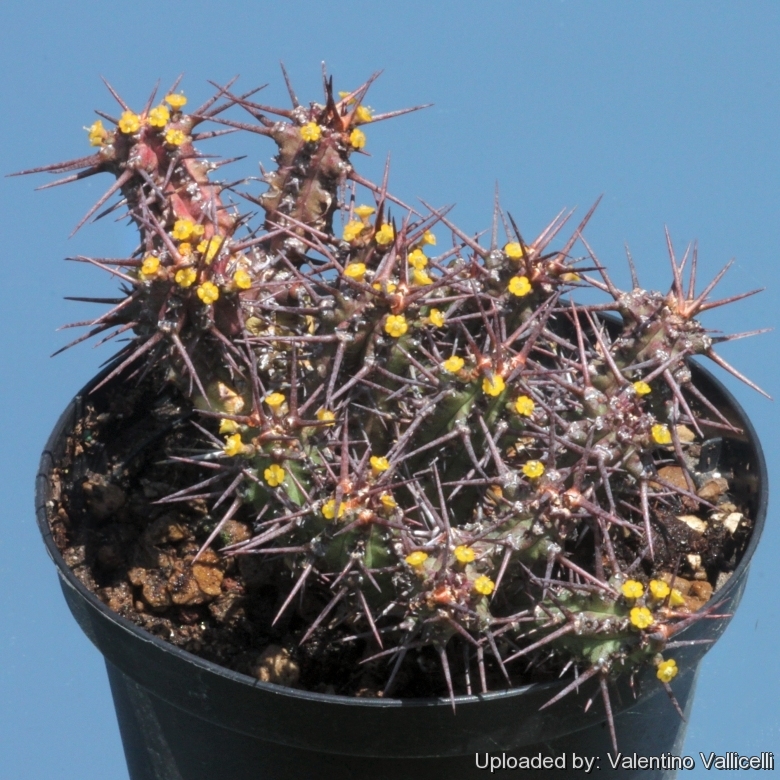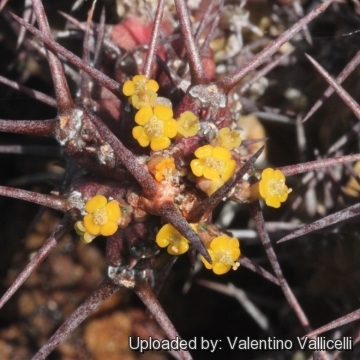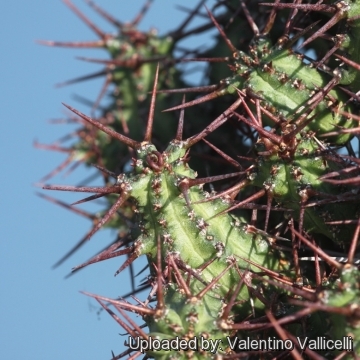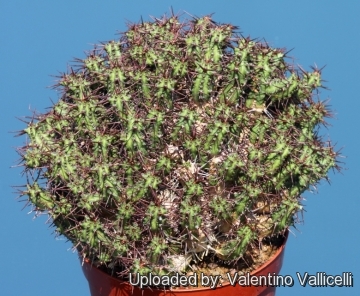
Euphorbia phillipsiae Photo by: Valentino Vallicelli
Origin and Habitat: Woqooyi Galbeed Region, Golis Range, North West Somalia.
Altitude: Approx 1500-1650 metres above sea level.
Habitat: Grows in crevices on north-facing rocky slopes in escarpments of limestone often very well camouflaged and barely visible between the rocks with Buxus hildebrandtii deciduous bushland. This rocky habitats harbour a rich succulent flora comprising: Whitesloanea crassaSN|12774]]SN|12774]], Pseudolithos cubiformisSN|12762]]SN|12762]], Aloe somaliensis, Aloe hemmingii, Euphorbia inculta, Edithcolea grandisSN|26305]]SN|26305]], Monadenium ellenbeckiiSN|20566]]SN|20566]], Kleinia gunnisii and Echidnopsis ciliataSN|30425]]SN|30425]].
Synonyms:
See all synonyms of Euphorbia phillipsiae
back
Accepted name in llifle Database:Euphorbia phillipsiae N.E.Br.Gard. Chron. III, 1903: 370 1903Synonymy: 2
back
Description: Euphorbia phillipsiaeSN|22225]]SN|26253]], originally released as Euphorbia golisanaSN|26254]]SN|26254]], is a compact cushions forming succulent. It is of small growth, and is a most interesting plant, one of the rarest of the genus.
Habit: The plants branch prolifically from the base to form dense hemispherical mounds up to 25 cm in height and diameter.
Stems: Terete, 1,5-2(-3) cm in diameter, grey-green to dark-green, usually with 7-9 ribs separated by deep grooves, with sinuate teeth to 6 mm apart.
Leaves: Small, triangular, and deciduous.
Stipular spines: Up to 5 mm long and 2.5 mm broad, separate.
Spines: Very variable , 0,5-18 mm on the same branch.
Inflorescences (cymes): Solitary, simple.
Flowers (cyathia): Yellow, approx 3 mm in diameter on 7 mm long peduncles. Nectar-glands oblong, yellow, just touching. Ovary obtusely lobed, exserted on a recurved stalk.
Remarks: E. phillipsiae as misapplied by many authors: See Euphorbia phillipsioidesSN|26253]]SN|22225]].
Bibliography: Major references and further lectures
1) Werner Rauh “The Wonderful World of Succulents: Cultivation and Description of Selected Succulent Plants Other Than Cacti” Smithsonian Institution Press, 1984
2) Hermann Jacobsen “A handbook of succulent plants: descriptions, synonyms, and cultural details for succulents other than Cactaceae” Volume 1 Blandford Press, 1960
3) James Cullen, Sabina G. Knees, H. Suzanne Cubey “The European Garden Flora Flowering Plants: A Manual for the Identification of Plants Cultivated in Europe, Both Out-of-Doors and Under Glass” Cambridge University Press, 11/ago/2011
4) Fl. Pl. South Africa 35: t.1395 1962
5) Sara Oldfield “Cactus and Succulent Plants: Status Survey and Conservation Action Plan” IUCN, 1997
 Euphorbia phillipsiae Photo by: Valentino Vallicelli
Euphorbia phillipsiae Photo by: Valentino Vallicelli Euphorbia phillipsiae Photo by: Valentino Vallicelli
Euphorbia phillipsiae Photo by: Valentino Vallicelli Euphorbia phillipsiae Photo by: Valentino Vallicelli
Euphorbia phillipsiae Photo by: Valentino Vallicelli Euphorbia phillipsiae Photo by: Valentino Vallicelli
Euphorbia phillipsiae Photo by: Valentino VallicelliCultivation and Propagation: Euphorbia phillipsiaeSN|26253]]SN|26253]] is a relatively easy to grow plant for pot culture.
Soil: It grows well in a very draining mineral potting substrate, but it isn't picky about soil.
Watering: It can be watered moderately all year around (except in the coldest month of the winter, as it rots easily, especially if overly wet). During the summer they enjoy average feeding and watering.
Hardiness: When dormant in winter, keep it totally dry at or around 10°C, even though it seems to tolerate lower temperatures.
Exposure: They do need a lot of light to keep their compact growth-form. Sometimes, in really hot full sun all day long, a plant will bleach out a bit
Propagation: It is propagated by cuttings (It branches enthusiastically, and offsets are readily available). If you remove an offset, remember to let it dry for a week or so, letting the wound heal (cuttings planted too soon easily rot before they can grow roots). It is better to wash the cut to remove the latex.
Warning: As with all other Euphorbias when a plant get damaged it exudes a thick white milky sap known as latex. This latex is poisonous, and may irritate skin. Pay extreme attention not to get any in your eyes or mouth.
Cultivated plants must be handled carefully.














